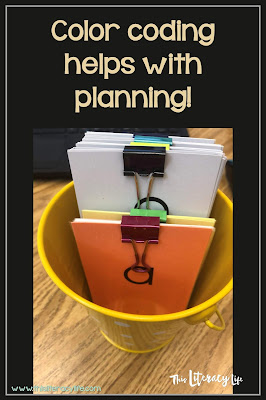As I said before, once the training was over, I thought I was ready to take on the world! But the planning and organization ~ oh my!
After finding out where my students fell using the PALS assessment, which we use in Virginia for all K-3 students, I was able to group them based on the spelling features they struggled with. I ended up with two groups of third graders, both in different places.
With two different groups, I knew I needed a second set of drill cards. I purchased those and laminated them, so they would last longer. Then I began cutting and cutting and cutting!
Writing the lesson plan wasn't the hard part. There was a nice template for those. I just had to remember which group they were for. I used a binder for each of them and kept everything together in one place.
But the drill cards! Having to separate them for two different groups was the challenge. I made sure I had two sets (actually 3, just in case) and kept them in separate containers. When I sorted them for each group, I had them in two different buckets with colored binder clips for each drill. This helped me know what to do.
I did use the Chromebooks, but always had the cards ready, just in case something didn't work out like I planned. And that happened more than I like to admit!
The notebooks were my favorite part of the time. This is where it solidified our learning and gave us a place to go back and review as needed. There was no way I was going to write everything in 10 different notebooks, so I created the pages for the students and used those with them. We interacted with those and reviewed them each week.
You can purchase those notebook pages from my Teachers Pay Teachers store by clicking here or on the picture below.
At the end of each session, I took some time to make notes on progress and plan for the next session. This happened to be the trickiest part of it all. Putting the cards back and getting more out helped me find exactly what I needed. My table may have looked like a mess, but I made sure I was ready for the next day. Planning too far ahead could not happen because I had to take time to make sure my groups were "getting it". Moving ahead too quickly would hurt them, and we had to keep it moving while learning.
I'm gearing up for this year and trying new things as I go. Having everything ready will help me to be better prepared to make the magic work again!
And if you would like to see more about how I use Orton-Gillingham in my interventions, check out these posts.
Orton-Gillingham in Small Groups: Working Magic Daily
Orton-Gillingham in Small Groups: Planning for Success
Orton-Gillingham in Small Groups: The All Important Notebook
Orton-Gillingham in Small Groups: Engaging Students All the Time
Orton-Gillingham in Small Groups: Designing Your Space
Orton-Gillingham in Small Groups: Engaging in SOS

























No comments
Leave a comment, tell me your thoughts!